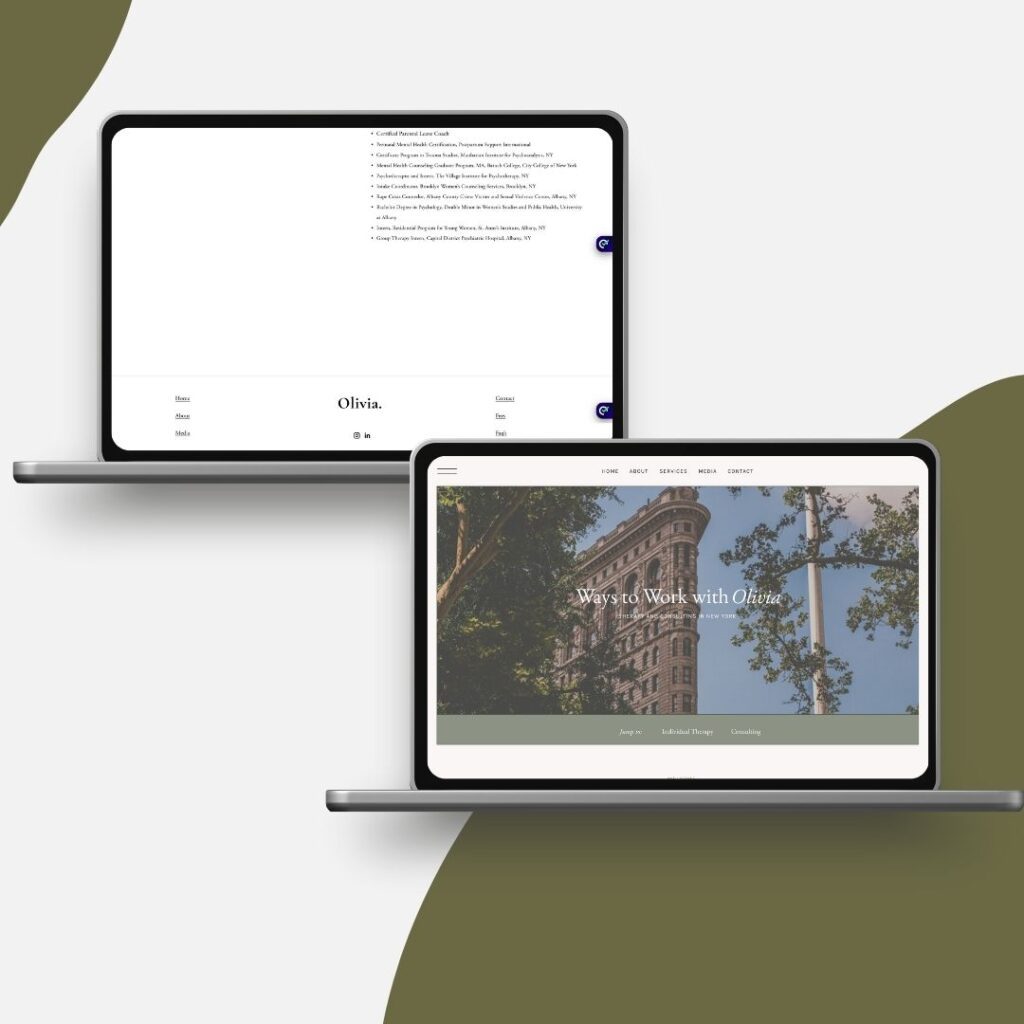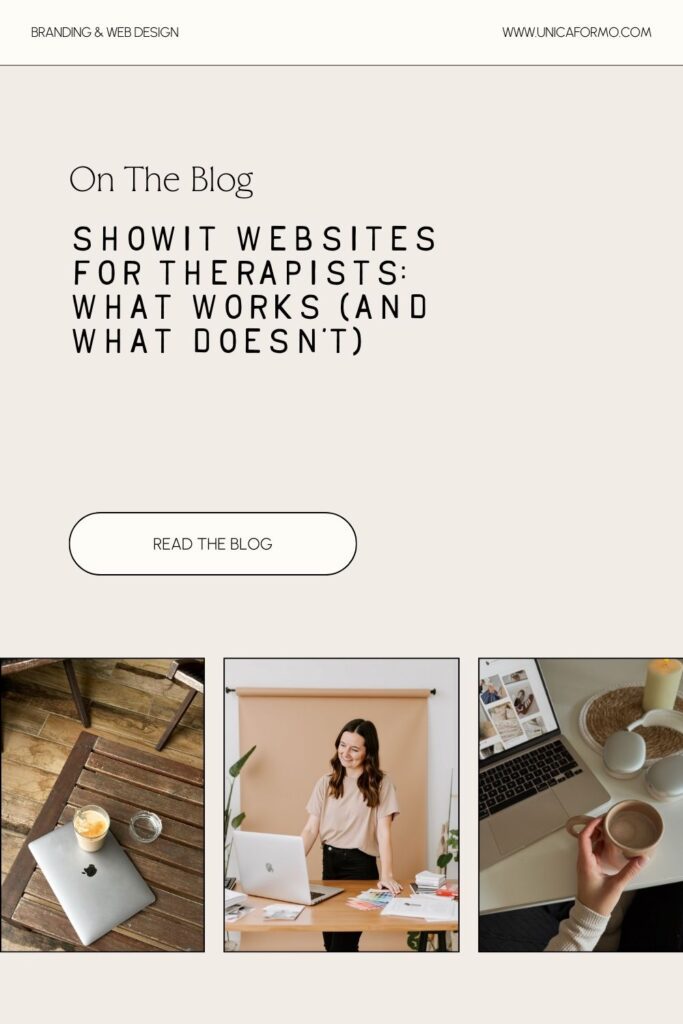As a therapist, your website is often the first introduction a potential client has to your practice. Before they ever reach out, they’re already forming an impression about your professionalism, your style of therapy, and whether they can picture themselves sitting across from you in session. That’s why having a website that’s both beautiful and functional matters.
For many in private practice, Showit websites for therapists are the perfect solution. Showit gives you creative flexibility, no coding required, and easy blogging capabilities through WordPress. But not every design choice or feature actually serves your goals—or your clients’.
After working with multiple therapists on their Showit websites, I’ve seen exactly what works (and what doesn’t). This guide breaks it down so you can make smart decisions and avoid the common mistakes that hold therapists back online.
👉 View my Therapist website portfolio here.
Is Showit a Good Website Platform for Therapists?
In short: yes. Showit is one of the best website platforms for therapists and counselors because it balances flexibility, design freedom, and ease of use.
Here’s why it works so well for private practice websites:
- Design freedom: You’re not stuck with cookie-cutter layouts—you can reflect your unique personality and therapeutic approach.
- Ease of use: Drag-and-drop editing makes it possible to update your own site without hiring a developer every time.
- Blogging power: Since Showit integrates with WordPress, you get the best of both worlds: custom design plus a content system that’s SEO-friendly.
👉 *Related* Read ‘Therapist Website SEO Best Practices: How to Rank Higher and Attract More Clients‘ - Mobile responsiveness: Showit allows separate design control for desktop and mobile, ensuring your site looks good everywhere.
Now, let’s get into what actually makes a therapist website effective—and what can work against you.
What Works on Showit Websites for Therapists
1. Clear, Client-Centered Messaging
Your site isn’t about impressing colleagues—it’s about making potential clients feel seen and understood. The most effective therapy websites:
- Use plain, empathetic language instead of clinical jargon.
- Lead with the problems clients are facing (anxiety, burnout, relationship struggles) before explaining the therapeutic approach.
- Include strong calls-to-action like “Schedule a free consultation” or “Get started today.”
💡 Example: Instead of “Cognitive Behavioral Therapy sessions available,” try “If anxiety feels like it’s running your life, I can help you build tools to find calm and control.”
2. Professional But Welcoming Design
Therapist website design works best when it feels both professional and approachable. The strongest Showit therapist websites often feature:
- Soft, calming colors (earth tones, blues, neutrals).
- Plenty of white space for a non-overwhelming feel.
- Professional headshots that show warmth, not stiffness.
Avoid overly dark, busy, or corporate designs—they can feel cold or intimidating to a potential client.

3. Easy-to-Find Contact Information
One of the biggest frustrations for potential clients is struggling to figure out how to reach you. Your Showit site should have:
- A Contact button in the main menu.
- A simple form that doesn’t overwhelm clients with too many fields.
- Your email and phone number clearly listed.
- If applicable, your office address or telehealth disclaimer.
4. A Services Page That Speaks to Client Needs
Rather than just listing therapy modalities (CBT, EMDR, EFT), write service descriptions that connect each approach to real client struggles.
💡 Example:
- Instead of: “Offering EMDR therapy for trauma.”
- Try: “If you’ve been carrying the weight of painful past experiences, EMDR can help you process and move forward.”
This balance of SEO keywords and client-friendly messaging works perfectly on Showit, where you can design layouts that make text feel approachable.
👉 *Related* Read ‘Wellness Website Copywriting: What Your Website Says About Your Business‘
5. Blog Content That Supports SEO
Showit + WordPress is an excellent combo for blogging. Therapists who blog consistently see better SEO results, especially when they:
- Answer client questions in blog form (e.g., “How to Know If Therapy Is Right for You” or “Coping Strategies for Burnout”).
- Use internal links to guide readers to services and contact pages.
- Include practical, actionable tips to establish authority and trust.
6. HIPAA-Friendly Practices
While your website itself doesn’t need to be HIPAA-compliant, anything involving protected health information (PHI) does. What works:
- Secure contact forms that don’t ask for personal health details.
- Using client portals (SimplePractice, TherapyNotes) for scheduling and secure communication.
- Clear disclaimers about not providing therapy advice over email.
What Doesn’t Work on Showit Websites for Therapists
1. Overly Clinical or Generic Copy
If your site sounds like it could belong to any therapist, it won’t connect. Copy that focuses on your training and modalities first often misses the client’s pain points.
❌ Example: “I provide CBT, DBT, and ACT interventions for mood disorders.”
✅ Better: “If you’re feeling stuck in cycles of negative thoughts, I’ll help you develop tools to break free and move forward.”
2. Hard-to-Use Navigation
Therapists sometimes make the mistake of cramming every possible page into the menu. Potential clients don’t want to dig. Stick to:
- Home
- About
- Services
- Blog (optional)
- Contact
Anything else (resources, FAQs, speaking) can live in the footer.
3. Stock Photos That Don’t Feel Authentic
We’ve all seen the cliché therapy stock photos: cold, dated shots of people on couches, staged “discerning looks,” or someone staring sadly out a window. Those don’t actually connect with potential clients—they can even make therapy feel more intimidating or clinical.
Instead, I recommend two routes:
- Authentic brand photography of yourself in your office or in settings that feel natural.
- Uplifting stock photos that show clients what’s possible—calmness, connection, and relief—rather than reflecting the heaviness they’re already experiencing.
Think sunlight through trees, a cozy mug on a table, a person journaling in a peaceful space. Clients want to envision where they could be, not stay stuck in the feeling they’re trying to escape.
4. Walls of Text Without Visual Flow
Therapy topics can be heavy—if your site looks like a research paper, clients may click away. Showit makes it easy to:
- Break up sections with headers.
- Use icons or small graphics.
- Add testimonials or callout boxes to create visual relief.
5. Ignoring Mobile Design
Showit lets you fully customize mobile layouts. Many therapists forget to check this, and a site that looks great on desktop can feel broken on a phone. Since most clients browse on mobile, don’t skip this step!
Quick Checklist: A Showit Website That Works for Therapists
- Warm, approachable design (colors, fonts, photos).
- Messaging that speaks directly to client struggles and goals.
- Clear navigation with services and contact easy to find.
- SEO-friendly blog content on WordPress.
- Contact form that’s simple, not invasive.
- Mobile layout designed intentionally.
- Authentic imagery (not overused stock photos).
FAQs About Therapist Website Design
Q: Do therapists really need a website?
Yes. A professional website is one of the first places potential clients will look to learn about your services, get a sense of your personality, and decide whether to reach out.
Q: What should a therapy website include?
At minimum: an about page, services page, contact information, and a clear call-to-action. Blog content and authentic photography can make a huge difference in attracting new clients.
Q: Is Showit good for therapy websites?
Absolutely. Showit’s drag-and-drop freedom and WordPress blogging power make it one of the best choices for therapists who want a site that feels personal, approachable, and easy to update.
👉 *Related* Read ‘What Makes a Showit Website Different? (And Why I Recommend It)‘
Q: Showit vs. Squarespace for therapists—which is better?
Squarespace is simple and affordable but can feel limiting in design and SEO. Showit offers far more creative control and integrates with WordPress for stronger blogging and long-term SEO growth.
Final Thoughts
A great Showit website for therapists doesn’t just look nice—it actively helps clients feel safe, understood, and ready to reach out. The design should reduce barriers, not add them, and your copy should connect with people on a human level while still supporting SEO.
If your website isn’t bringing in new clients, chances are it’s not working as hard for you as it could. The good news? With Showit, you have the flexibility to make changes without starting over.
👉 Ready to create a therapist website that works? Contact me here to get started.
www.pinterest.comPin for Later:


Jordin Brinn is the founder and lead designer of Unica Formo — a creative studio in Columbus, Ohio, specializing in custom Showit website design and brand strategy for service-based businesses like coaches, consultants, therapists, creatives, and wellness professionals. With over a decade of business experience, she helps clients bring strategy, clarity, and personality to their online presence.
Explore design services and free resources at unicaformo.com.
